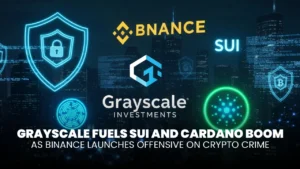TRON Scales Multichain Liquidity with Avail, while Sui Enables Seamless Self-Custodial Swaps

Two new integrations show how bridgeless, seamless interoperability is taking shape across different layers of crypto liquidity. TRON ($TRX) has partnered with Avail to extend its stablecoin-heavy network across more than ten chains without relying on traditional bridges, bringing safer, unified access for USDT and other stablecoin settlements.
- TRON’s Stablecoin-Centric, Bridgeless Interoperability
- Sui’s Native-Token, Self-Custodial Swaps
- What Changes for Users and Investors
- Why DPoS Matters In This Moment
- Conclusion
- Frequently Asked Questions About TRON and Sui’s Focus on Seamless Interoperability
- Is TRON’s integration primarily about stablecoins or TRX?
- Does Sui’s THORWallet route rely on wrapped tokens or centralized custody?
- Why is DPoS relevant to both stories?
- What does “bridgeless interoperability” actually remove from the path?
- What should investors watch next?
At the same time, THORWallet has activated direct, on-chain swaps between Sui’s (SUI) native token and major assets such as BTC, ETH, and SOL, giving users true non-custodial mobility. Together, these updates make clear that cross-chain connectivity now depends less on slogans and more on practical execution, whether that means stablecoin rails spanning multiple networks or native token swaps that move without friction.
THORWallet: “You can now swap across @SuiNetwork and major assets like BTC, ETH, and SOL, all on-chain.”
🚀 Big news from THORWallet: You can now swap across @SuiNetwork and major assets like BTC, ETH, and SOL all onchain, no bridges, fully non-custodial.
This unlocks seamless cross-chain DeFi with Sui’s ecosystem. 🌐
Update of the app should be available in your country soon.… pic.twitter.com/BWjyzgQqt7
— THORWallet (@Thorwallet) October 20, 2025
ALSO READ: Sui ETF Back in Limelight as Cboe Awaits SEC Decision on Canary ETF
Both TRON and Sui run Delegated Proof of Stake, or DPoS, which prioritizes fast finality while preserving tokenholder governance through validation delegation. That design choice matters when swaps and stablecoins move at scale.
TRON’s Stablecoin-Centric, Bridgeless Interoperability
TRON’s integration with Avail focuses on stablecoin liquidity at scale. Avail’s Nexus layer is designed to connect TRON to liquidity on more than ten blockchains while avoiding the conventional bridge architectures that depend on wrapped assets and custodial choke points. The promised experience emphasizes trust-minimized verification, unified access across networks, and simplified gas handling so dApps can move assets and messages as if they operated in a single environment.
For TRON, which anchors the largest USDT footprint by circulation and clears significant daily settlement volume, the upside is straightforward: reduce operational risk from wrapping and redeeming, compress user friction, and widen the surface area for stablecoin-denominated activity off-chain boundaries that used to slow routing.
ALSO READ: TRON Staking Goes Live on Ledger Live, Self-Custody Rewards Finally One Tap Away
The fit is also architectural. TRON’s Delegated Proof of Stake aims for fast confirmation and predictable costs, traits that matter when the primary payload is settlement in stable value rather than speculative flow. By leveraging Avail to abstract routing across multiple chains, TRON transitions from a single-chain fortress to more of a multichain logistics hub, where liquidity can be directed to the venue offering the best path without reintroducing the fragility of legacy bridge models.
Sui’s Native-Token, Self-Custodial Swaps
Sui’s development takes a different route to the same destination. THORWallet now supports direct, on-chain swaps between SUI and leading assets like BTC, ETH, SOL, and widely used ERC-20s. Funds settle on their respective chains, and custody remains with the user from start to finish. There is no centralized exchange detour and no reliance on wrapped representations. For newcomers, the practical change is immediate: acquiring or exiting SUI becomes a short, mobile-native flow that removes several steps and keeps control with the wallet owner.
MartyParty (market commentator): “$SUI News: @Thorwallet enables cross-chain swaps, no bridges, fully non-custodial.”
$SUI News: @Thorwallet enables cross chain swaps of $BTC $ETH $SOL natively on $SUI network. https://t.co/nOfVCxmFxr
— MartyParty (@martypartymusic) October 20, 2025
This path aligns with Sui’s technical profile. The network’s DPoS consensus and parallel execution aim for near-instant confirmations, which helps when routes must finalize quickly during volatile windows. Lowering the effort to reach Sui’s DeFi stack broadens the top of the funnel. Users can sample lending, trading, staking, or LP positions with fewer hurdles and without surrendering keys, which is the kind of UX improvement that tends to compound as more wallets and routers follow suit.
ALSO READ: Sui DEX Volume Hits ATH Amid Typus Exploit, SEC’s Green Signal to YLDS
What Changes for Users and Investors
For TRON participants, the expected improvement is a safer and simpler cross-chain settlement for stablecoins. If Avail’s model delivers as pitched, traders and dApps should see fewer brittle wrap-and-redeem workflows, less manual gas management, and more predictable routes across networks that previously felt siloed. That combination can translate into higher stablecoin velocity and broader market reach for TRON-based applications.
For Sui users, the upgrade reduces onboarding friction. A newcomer holding BTC, ETH, or SOL can swap directly into SUI from a mobile wallet and retain custody throughout. The path is shorter, the trust assumptions are smaller, and the experience invites trial. If liquidity deepens and routing remains transparent under stress, Sui’s DeFi venues should benefit from better price discovery and more consistent retail flow.
For risk managers on both sides, the diligence items remain familiar. Bridgeless designs reduce exposure to wrapped-asset contracts yet still depend on correct message passing and sound economic incentives. Wallet-level swaps require clear, auditable routing logic with reasonable slippage controls, especially during volatile markets. These integrations will be judged by their performance in busy hours rather than by their architecture diagrams.
Why DPoS Matters In This Moment
Delegated Proof of Stake underpins both networks’ ability to make cross-chain actions feel routine. Concentrating block production among elected validators shortens confirmation times and keeps throughput stable, which reduces settlement anxiety and failed routes. When users come to expect cross-chain behavior to “just work,” consensus that consistently finalizes quickly becomes part of the product, not just a line in the documentation.
Conclusion
Interoperability is no longer a thought experiment. TRON is extending its stablecoin rails across chains without traditional bridges, while Sui is offering native, self-custodial swaps that work on mobile and keep users in control. The two approaches address different layers of stablecoin logistics versus native-token mobility, but they converge on the same goal: secure, low-friction value transfer that fades into the background of ordinary use.
Crucially, both ecosystems rely on Delegated Proof of Stake (DPoS) to deliver fast finality and predictable throughput, the reliability that cross-chain routing needs at a consumer scale. For investors, the signal is clear: follow the rails, measure the friction, and watch execution quality as these integrations roll out. Liquidity tends to settle where confirmations are quick, fees are steady, and paths are shortest.
Frequently Asked Questions About TRON and Sui’s Focus on Seamless Interoperability
Is TRON’s integration primarily about stablecoins or TRX?
The integration is aimed at stablecoin-based interoperability, especially USDT, which already dominates flow on TRON. The goal is to move those balances across chains without the liabilities of wrapped assets.
Does Sui’s THORWallet route rely on wrapped tokens or centralized custody?
No. The swaps are native and on-chain, and custody stays with the user throughout the process. Funds settle on their respective chains without a centralized exchange.
Why is DPoS relevant to both stories?
DPoS helps deliver short finality and steady throughput. Those properties reduce failed routes and improve user confidence during cross-chain activity, where timing and reliability matter.
What does “bridgeless interoperability” actually remove from the path?
It removes conventional bridge contracts and wrapped representations. Assets move with fewer trust assumptions, and UX improves because users avoid wrap/redeem steps and ad-hoc gas juggling.
What should investors watch next?
Focus on live routing quality, slippage behavior in volatile hours, and how quickly wallets and dApps adopt these paths. The value accrues where users experience fewer steps and fewer surprises.




